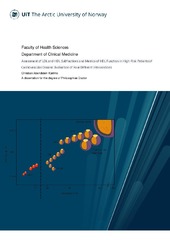| dc.description.abstract | Our research focused on assessing lipoprotein subfractions using the Lipoprint LDL® and HDL® system and evaluating metrics associated with HDL function. We examined data from four intervention trials involving high-risk patients of atherosclerotic cardiovascular disease (ASCVD). The interventions included lifestyle changes followed by bariatric surgery for morbidly obese patients, statin and ezetimibe therapy for elderly individuals, omega-3 polyunsaturated fatty acid (n3-PUFA) supplementation for patients with familial hypercholesterolemia (FH), and the switch from lipoprotein apheresis to a PCSK9 inhibitor in FH patients.
Interestingly, we found unexpectedly low baseline levels of high-risk small, dense LDL (sdLDL) in all study populations, including the morbidly obese patients. This could be attributed to the Lipoprint LDL® system measuring lower levels of sdLDL compared to other methods. None of the interventions had a clinically relevant impact on sdLDL levels. We did observe significant increases in the large HDL subfraction following lifestyle changes, bariatric surgery, and n3-PUFA supplementation. n3-PUFA also reduced the small HDL subfraction. Despite these changes, there were no notable alterations in cholesterol efflux capacity, which measures the ability of HDL particles to remove cholesterol from artery walls.
In summary, Lipoprint LDL® did not offer additional clinically relevant information compared to standard LDL measurements. While there were changes in HDL subfraction composition, we did not observe significant improvements in HDL function, and the clinical significance of HDL subfractions in predicting ASCVD risk remains uncertain. | en_US |
| dc.relation.haspart | <p>Paper 1: Kjellmo, C.A., Karlsson, H., Nestvold, T.K., Ljunggren, S., Cederbrant, K., Marcusson-Stahl, M., Mathisen, M., Lappegard, K.T. & Hovland, A. (2018). Bariatric surgery improves lipoprotein profile in morbidly obese patients by reducing LDL cholesterol, apoB, and SAA/PON1 ratio, increasing HDL cholesterol, but has no effect on cholesterol efflux capacity. <i>Journal of Clinical Lipidology, 12</i>(1), 193-202. Also available at <a href=https://doi.org/10.1016/j.jacl.2017.10.007>https://doi.org/10.1016/j.jacl.2017.10.007</a>.
<p>Paper 2: Lappegard, K.T., Kjellmo, C.A., Ljunggren, S., Cederbrant, K., Marcusson-Stahl, M., Mathisen, M., Karlsson, H. & Hovland, A. (2018). Lipoprotein apheresis affects lipoprotein particle subclasses more efficiently compared to the PCSK9 inhibitor evolocumab, a pilot study. <i>Transfusion and Apheresis Science, 57</i>(1), 91-96. Also available at <a href=http://dx.doi.org/10.1016/j.transci.2018.01.002>http://dx.doi.org/10.1016/j.transci.2018.01.002</a>.
<p>Paper 3: Kjellmo, C.A., Pop, G., Lappegard, K.T. & Hovland, A. (2019). Intensive lipid-lowering therapy reduces large, but not small, dense low-density lipoprotein particles measured by gel electrophoresis, in elderly patients with atrial fibrillation. <i>European Journal of Preventive Cardiology, 26</i>(18), 2017-2018. Also available at <a href=https://doi.org/10.1177/2047487319845966>https://doi.org/10.1177/2047487319845966</a>.
<p>Paper 4: Hande, L.N., Kjellmo, C., Pettersen, K., Ljunggren, S., Karlsson, H., Cederbrant, K., Marcusson-Stahl, M., Hovland, A. & Lappegard, K.T. (2022). Effect of N-3 Polyunsaturated Fatty Acids on Lipid Composition in Familial Hypercholesterolemia: A Randomized Crossover Trial. <i>Biomedicines, 10</i>(8), 1809. Also available in Munin at <a href=https://hdl.handle.net/10037/27798>https://hdl.handle.net/10037/27798</a>. | en_US |


 English
English norsk
norsk
